traction control SKODA FABIA 2006 2.G / 5J Owner's Manual
[x] Cancel search | Manufacturer: SKODA, Model Year: 2006, Model line: FABIA, Model: SKODA FABIA 2006 2.G / 5JPages: 258, PDF Size: 44.86 MB
Page 28 of 258
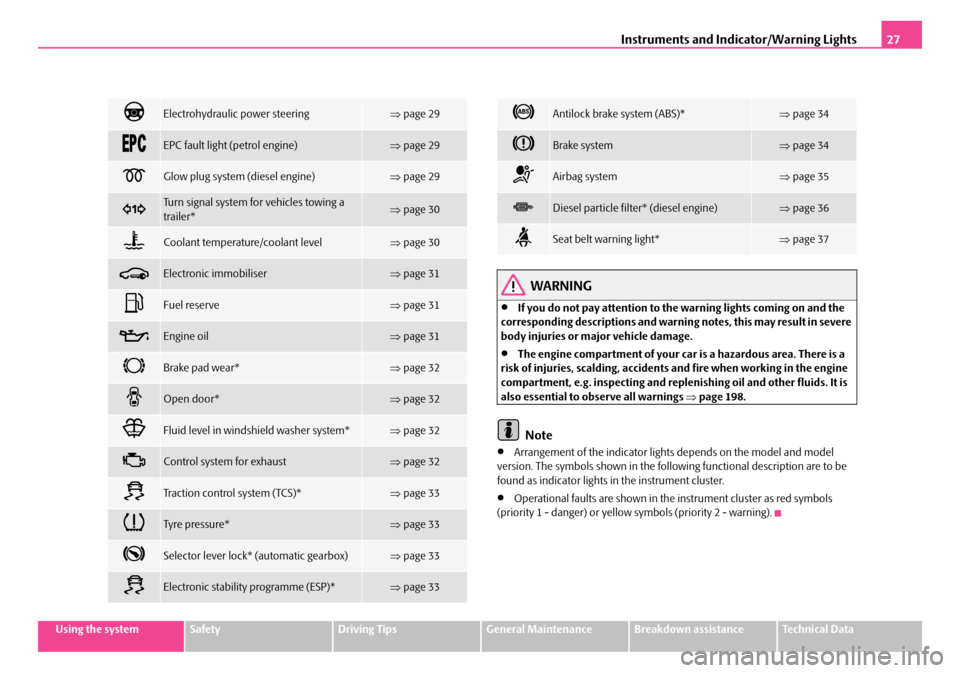
Instruments and Indicator/Warning Lights27
Using the systemSafetyDriving TipsGeneral MaintenanceBreakdown assistanceTechnical Data
WARNING
•If you do not pay attention to the warning lights coming on and the corresponding descriptions and warning notes, this may result in severe body injuries or major vehicle damage.
•The engine compartment of your car is a hazardous area. There is a risk of injuries, scalding, accidents and fire when working in the engine compartment, e.g. inspecting and replenishing oil and other fluids. It is also essential to observe all warnings ⇒page 198.
Note
•Arrangement of the indicator lights depends on the model and model version. The symbols shown in the following functional description are to be found as indicator lights in the instrument cluster.
•Operational faults are shown in the instrument cluster as red symbols (priority 1 - danger) or yellow symbols (priority 2 - warning).
Electrohydraulic power steering⇒ page 29
EPC fault light (petrol engine)⇒page 29
Glow plug system (diesel engine)⇒page 29
Turn signal system for vehicles towing a trailer*⇒ page 30
Coolant temperature/coolant level⇒page 30
Electronic immobiliser⇒page 31
Fuel reserve⇒page 31
Engine oil⇒page 31
Brake pad wear*⇒page 32
Open door*⇒page 32
Fluid level in windshield washer system*⇒page 32
Control system for exhaust⇒page 32
Traction control system (TCS)*⇒page 33
Tyre pressure*⇒page 33
Selector lever lock* (automatic gearbox)⇒page 33
Electronic stability programme (ESP)*⇒page 33
Antilock brake system (ABS)*⇒page 34
Brake system⇒page 34
Airbag system⇒page 35
Diesel particle filter* (diesel engine)⇒page 36
Seat belt warning light*⇒page 37
NKO A05Fabia 20.book Page 27 Tuesday, September 26, 2006 8:38 AM
Page 35 of 258
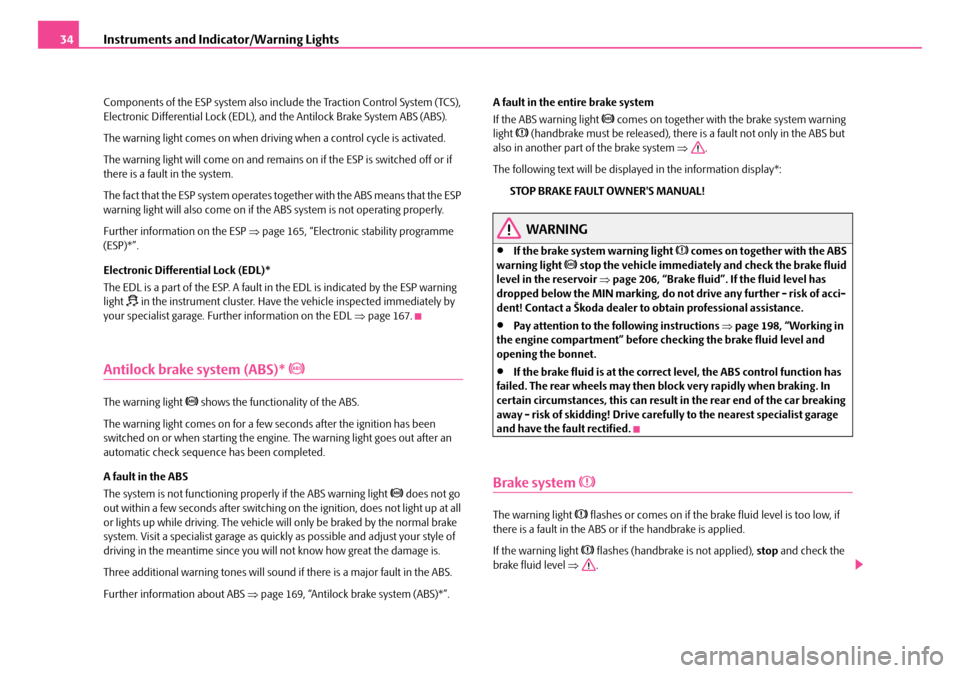
Instruments and Indicator/Warning Lights34
Components of the ESP system also include the Traction Control System (TCS), Electronic Differential Lock (EDL), and the Antilock Brake System ABS (ABS).
The warning light comes on when drivin g when a control cycle is activated.
The warning light will come on and remains on if the ESP is switched off or if there is a fault in the system.
The fact that the ESP system operates together with the ABS means that the ESP warning light will also come on if the ABS system is not operating properly.
Further information on the ESP ⇒page 165, “Electronic stability programme (ESP)*”.
Electronic Differential Lock (EDL)*
The EDL is a part of the ESP. A fault in the EDL is indicated by the ESP warning light in the instrument cluster. Have the vehicle inspected immediately by your specialist garage. Further information on the EDL ⇒page 167.
Antilock brake system (ABS)*
The warning light shows the functionality of the ABS.
The warning light comes on for a few seconds after the ignition has been switched on or when starting the engine. The warning light goes out after an automatic check sequence has been completed.
A fault in the ABS
The system is not functioning properly if the ABS warning light does not go out within a few seconds after switching on the ignition, does not light up at all or lights up while driving. The vehicle wi ll only be braked by the normal brake system. Visit a specialist garage as quickly as possible and adjust your style of driving in the meantime since you will not know how great the damage is.
Three additional warning tones will sound if there is a major fault in the ABS.
Further information about ABS ⇒page 169, “Antilock brake system (ABS)*”.
A fault in the entire brake system
If the ABS warning light comes on together with the brake system warning light (handbrake must be released), ther e is a fault not only in the ABS but also in another part of the brake system ⇒.
The following text will be displayed in the information display*:
STOP BRAKE FAULT OWNER'S MANUAL!
WARNING
•If the brake system warning light comes on together with the ABS warning light stop the vehicle immediatel y and check the brake fluid level in the reservoir ⇒page 206, “Brake fluid”. If the fluid level has dropped below the MIN marking, do not drive any further - risk of acci- dent! Contact a Škoda dealer to obtain professional assistance.
•Pay attention to the following instructions ⇒page 198, “Working in the engine compartment” before checking the brake fluid level and opening the bonnet.
•If the brake fluid is at the correct level, the ABS control function has failed. The rear wheels may then bloc k very rapidly when braking. In certain circumstances, this can result in the rear end of the car breaking away - risk of skidding! Drive carefu lly to the nearest specialist garage and have the fault rectified.
Brake system
The warning light flashes or comes on if the brake fluid level is too low, if there is a fault in the ABS or if the handbrake is applied.
If the warning light flashes (handbrake is not applied), stop and check the brake fluid level ⇒.
NKO A05Fabia 20.book Page 34 Tuesday, September 26, 2006 8:38 AM
Page 166 of 258

Intelligent Technology165
Using the systemSafetyDriving TipsGeneral MaintenanceBreakdown assistanceTechnical Data
Driving Tips
Intelligent Technology
Electronic stability programme (ESP)*
General
General
The ESP aids you maintain control of your vehicle in situations in borderline driving situations such as when negotiatin g a curve too fast. The risk of skidding is reduced and your car thus offers greater driving stability depending on the conditions of the road surface. This occurs at all speeds.
The following systems are integrated in to the electronic stability programme:
•Electronic Differential Lock (EDL),
•Traction control system (TCS),
•Antilock brake system (ABS),
•Brake Assist.
Operating principle
The ESP switches on automatically wh en the engine is started and then conducts a self-test. The ESP control uni t processes data from the individual systems. It also processes additional measurement data which are supplied by highly sensitive sensors: the rotational velocity of the vehicle about its vertical axis, the lateral acceleration of the vehicle, the braking pressure and the steering angle.
The direction which the driver wishes to take is determined based on the steering angle and the speed of the vehicle and is constantly compared with the actual behaviour of the vehicl e. If differences exist, such as the car beginning to skid, the ESP will automatically brake the appropriate wheel.
The car is stabilised again by the forces which take effect when the wheel is braked. Intervention into the brake system takes place primarily on the outer front wheel of a vehicle which tends to oversteer (tendency for the rear of the vehicle to break away) while occurs this is on the inner rear wheel of a vehicle which tends to understeer (tendency to shift out of the curve). This braking control cycle is accompanied by noises.
The ESP operates in combination with the ABS ⇒page 169, “Antilock brake system (ABS)*”. If there is a fault in the ABS system, the ESP also does not operate.
The ESP warning light ⇒page 33 lights up in the instrument cluster when there is a fault on the ESP.
Fig. 133 ESP switch
NKO A05Fabia 20.book Page 165 Tuesday, September 26, 2006 8:38 AM
Page 167 of 258
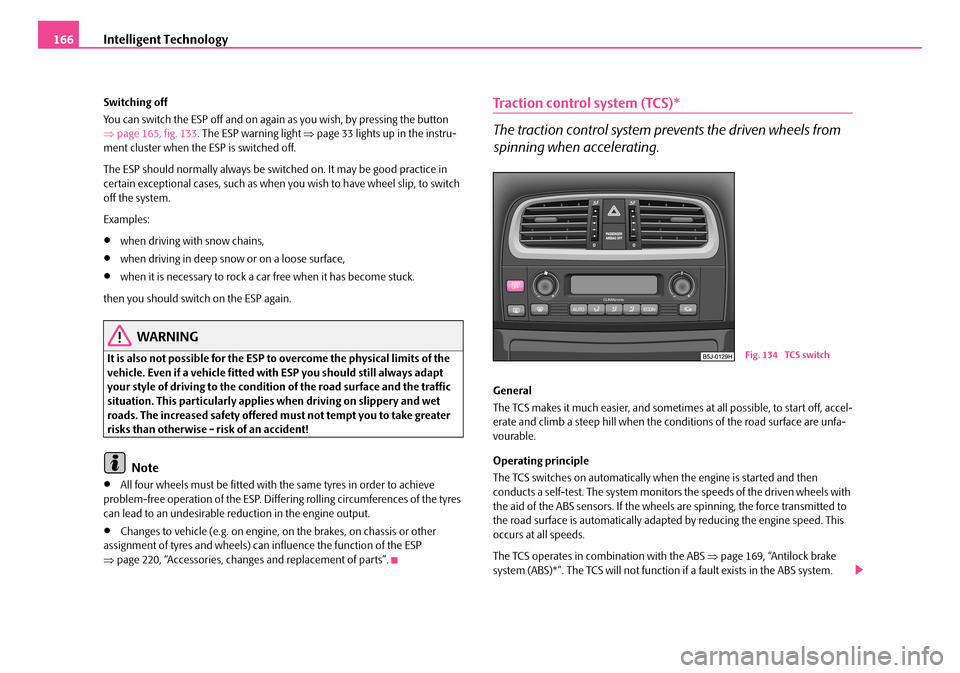
Intelligent Technology166
Switching off
You can switch the ESP off and on again as you wish, by pressing the button ⇒ page 165, fig. 133. The ESP warning light ⇒page 33 lights up in the instru- ment cluster when the ESP is switched off.
The ESP should normally al ways be switched on. It may be good practice in certain exceptional cases, such as when you wish to have wheel slip, to switch off the system.
Examples:
•when driving with snow chains,
•when driving in deep snow or on a loose surface,
•when it is necessary to rock a car free when it has become stuck.
then you should switch on the ESP again.
WARNING
It is also not possible for the ESP to overcome the physical limits of the vehicle. Even if a vehicle fitted with ESP you should still always adapt your style of driving to the condition of the road surface and the traffic situation. This particularly applies when driving on slippery and wet roads. The increased safety offered must not tempt you to take greater risks than otherwise - risk of an accident!
Note
•All four wheels must be fitted with the same tyres in order to achieve problem-free operation of the ESP. Differ ing rolling circumferences of the tyres can lead to an undesirable reduction in the engine output.
•Changes to vehicle (e.g. on engine, on the brakes, on chassis or other assignment of tyres and wheels) can influence the function of the ESP ⇒ page 220, “Accessories, changes and replacement of parts”.
Traction control system (TCS)*
The traction control system prevents the driven wheels from
spinning when accelerating.
General
The TCS makes it much easier, and sometimes at all possible, to start off, accel- erate and climb a steep hill when the co nditions of the road surface are unfa- vourable.
Operating principle
The TCS switches on automatically when the engine is started and then conducts a self-test. The system monitors the speeds of the driven wheels with the aid of the ABS sensors. If the wheels are spinning, the force transmitted to the road surface is automatically adap ted by reducing the engine speed. This occurs at all speeds.
The TCS operates in combination with the ABS ⇒page 169, “Antilock brake system (ABS)*”. The TCS will not function if a fault exists in the ABS system.
Fig. 134 TCS switch
NKO A05Fabia 20.book Page 166 Tuesday, September 26, 2006 8:38 AM
Page 219 of 258
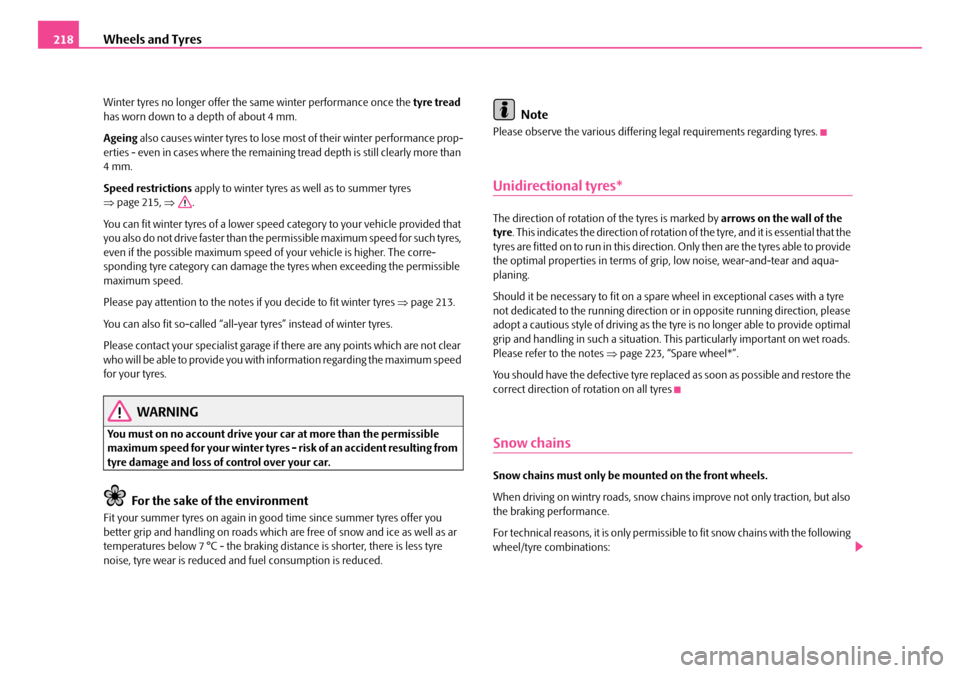
Wheels and Tyres218
Winter tyres no longer offer the same winter performance once the tyre tread has worn down to a depth of about 4 mm.
Ageing also causes winter tyres to lose most of their winter performance prop- erties - even in cases where the remaining tread depth is still clearly more than 4 mm.
Speed restrictions apply to winter tyres as well as to summer tyres ⇒ page 215, ⇒.
You can fit winter tyres of a lower speed category to your vehicle provided that you also do not drive faster than the permissible maximum speed for such tyres, even if the possible maximum speed of your vehicle is higher. The corre- sponding tyre category can damage th e tyres when exceeding the permissible maximum speed.
Please pay attention to the notes if you decide to fit winter tyres ⇒page 213.
You can also fit so-called “all-year tyres” instead of winter tyres.
Please contact your specialist garage if there are any points which are not clear who will be able to provide you with information regarding the maximum speed for your tyres.
WARNING
You must on no account drive your car at more than the permissible maximum speed for your winter tyres - risk of an accident resulting from tyre damage and loss of control over your car.
For the sake of the environment
Fit your summer tyres on again in good time since summer tyres offer you better grip and handling on roads which are free of snow and ice as well as ar temperatures below 7 °C - the braking distance is shorter, there is less tyre noise, tyre wear is reduced and fuel consumption is reduced.
Note
Please observe the various differing legal requirements regarding tyres.
Unidirectional tyres*
The direction of rotation of the tyres is marked by arrows on the wall of the tyre . This indicates the direction of rotation of the tyre, and it is essential that the tyres are fitted on to run in this direction. Only then are the tyres able to provide the optimal properties in terms of grip, low noise, wear-and-tear and aqua- planing.
Should it be necessary to fit on a spar e wheel in exceptional cases with a tyre not dedicated to the running direction or in opposite running direction, please adopt a cautious style of driving as the tyre is no longer able to provide optimal grip and handling in such a situation. This particularly important on wet roads. Please refer to the notes ⇒page 223, “Spare wheel*”.
You should have the defective tyre replaced as soon as possible and restore the correct direction of rotation on all tyres
Snow chains
Snow chains must only be mounted on the front wheels.
When driving on wintry roads, snow chains improve not only traction, but also the braking performance.
For technical reasons, it is only permissi ble to fit snow chains with the following wheel/tyre combinations:
NKO A05Fabia 20.book Page 218 Tuesday, September 26, 2006 8:38 AM
Page 220 of 258
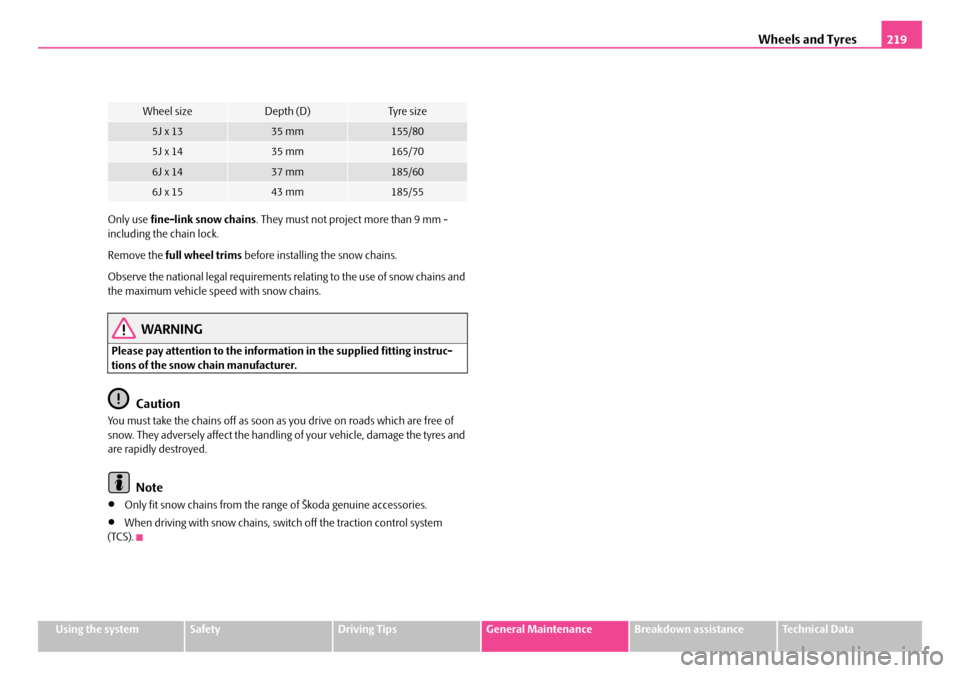
Wheels and Tyres219
Using the systemSafetyDriving TipsGeneral MaintenanceBreakdown assistanceTechnical Data
Only use fine-link snow chains. They must not project more than 9 mm - including the chain lock.
Remove the full wheel trims before installing the snow chains.
Observe the national legal requirements relating to the use of snow chains and the maximum vehicle speed with snow chains.
WARNING
Please pay attention to the information in the supplied fitting instruc-tions of the snow chain manufacturer.
Caution
You must take the chains off as soon as you drive on roads which are free of snow. They adversely affect the handling of your vehicle, damage the tyres and are rapidly destroyed.
Note
•Only fit snow chains from the ra nge of Škoda genuine accessories.
•When driving with snow chains, switch off the traction control system (TCS).
Wheel sizeDepth (D)Tyre s iz e
5J x 1335 mm155/80
5J x 1435 mm165/70
6J x 1437 mm185/60
6J x 1543 mm185/55
NKO A05Fabia 20.book Page 219 Tuesday, September 26, 2006 8:38 AM
Page 255 of 258

Index254
Tool . . . . . . . . . . . . . . . . . . . . . . . . . . . . . . . . . . . . . . . . 222
Towing a trailer . . . . . . . . . . . . . . . . . . . . . . . . . . . . . . 181
Towing eye
front . . . . . . . . . . . . . . . . . . . . . . . . . . . . . . . . . . . . 232
rear . . . . . . . . . . . . . . . . . . . . . . . . . . . . . . . . . . . . . 233
Towing protection . . . . . . . . . . . . . . . . . . . . . . . . . . . . 49
towing vehicle . . . . . . . . . . . . . . . . . . . . . . . . . . . . . . 231
Tow-starting . . . . . . . . . . . . . . . . . . . . . . . . . . . . . . . . 231
Tow-starting and towing vehicle
Automatic gearbox . . . . . . . . . . . . . . . . . . . . . . . 117
Traction control system (TCS) . . . . . . . . . . . . . . . . . 166
Warning light . . . . . . . . . . . . . . . . . . . . . . . . . . . . . 33
Trailer . . . . . . . . . . . . . . . . . . . . . . . . . . . . . . . . . . . . . . 181
General Maintenance . . . . . . . . . . . . . . . . . . . . 181
Transporting children safely . . . . . . . . . . . . . . . . . . 155
Tread depth . . . . . . . . . . . . . . . . . . . . . . . . . . . . . . . . . 215
Turn signal light . . . . . . . . . . . . . . . . . . . . . . . . . . . . . 242
Turn signal lights . . . . . . . . . . . . . . . . . . . . . . . . . . . . . 60
Warning light . . . . . . . . . . . . . . . . . . . . . . . . . . . . . 28
Turn signal system for ve hicles towing a trailer
Warning light . . . . . . . . . . . . . . . . . . . . . . . . . . . . . 30
Two-way radio systems . . . . . . . . . . . . . . . . . . . . . . 129
Type plate . . . . . . . . . . . . . . . . . . . . . . . . . . . . . . . . . . 247
Tyre . . . . . . . . . . . . . . . . . . . . . . . . . . . . . . . . . . . . . . . . 214
Tyre inflation pressure
Warning light . . . . . . . . . . . . . . . . . . . . . . . . . . . . . 33
Tyre repair kit . . . . . . . . . . . . . . . . . . . . . . . . . . . . . . . 222
Tyres
Winter tyres . . . . . . . . . . . . . . . . . . . . . . . . . . . . . 217
U
Underbody protection . . . . . . . . . . . . . . . . . . . . . . . 190
Unidirectional tyres . . . . . . . . . . . . . . . . . . . . . . . . . . 218
Unlocking . . . . . . . . . . . . . . . . . . . . . . . . . . . . . . . . . . . . . 41
Remote control . . . . . . . . . . . . . . . . . . . . . . . . . . . . 47
V
Vanity mirror . . . . . . . . . . . . . . . . . . . . . . . . . . . . . . . . . . 64
Vehicle data sticker . . . . . . . . . . . . . . . . . . . . . . . . . . 247
Vehicle identification data . . . . . . . . . . . . . . . . . . . . 247
Vehicle tool kit . . . . . . . . . . . . . . . . . . . . . . . . . . . . . . 222
Visors . . . . . . . . . . . . . . . . . . . . . . . . . . . . . . . . . . . . . . . . 64
W
W ashing vehicle by hand . . . . . . . . . . . . . . . . . . . . 186
Warning lights . . . . . . . . . . . . . . . . . . . . . . . . . . . . . . . . 26
Warning symbols . . . . . . . . . . . . . . . . . . . . . . . . . . . . . . 26
Warning triangle . . . . . . . . . . . . . . . . . . . . . . . . . . . . 221
Washing . . . . . . . . . . . . . . . . . . . . . . . . . . . . . . . . . . . . 186
with a high-pressure cleaner . . . . . . . . . . . . . . 187
Washing the vehicle . . . . . . . . . . . . . . . . . . . . . . . . . 185
Wax treatment . . . . . . . . . . . . . . . . . . . . . . . . . . . . . . 187
Wheel
Changing . . . . . . . . . . . . . . . . . . . . . . . . . . . . . . . . 223
Spare . . . . . . . . . . . . . . . . . . . . . . . . . . . . . . . . . . . 223
Wheel bolts . . . . . . . . . . . . . . . . . . . . . . . . . . . . . . . . . 217
Safety . . . . . . . . . . . . . . . . . . . . . . . . . . . . . . . . . . . 228
slackening and tightening . . . . . . . . . . . . . . . . . 227
Wheel bolts lock . . . . . . . . . . . . . . . . . . . . . . . . . . . . 228
Wheel trim . . . . . . . . . . . . . . . . . . . . . . . . . . . . . . 213, 225
Wheels . . . . . . . . . . . . . . . . . . . . . . . . . . . . . . . . . . . . . 213
Window . . . . . . . . . . . . . . . . . . . . . . . . . . . . . . . . . . . . . . 50
Windows
de-icing . . . . . . . . . . . . . . . . . . . . . . . . . . . . . . . . . 188
Windscreen washer nozzles . . . . . . . . . . . . . . . . . . . . 64
Windscreen Wiper and Washer System
Warning light . . . . . . . . . . . . . . . . . . . . . . . . . . . . . . 32
Windshield washer fluid reservoir . . . . . . . . . . . . 211
Warning light . . . . . . . . . . . . . . . . . . . . . . . . . . . . . . 32
Windshield washer system . . . . . . . . . . . . . . . . . . . 211
Windshield wiper . . . . . . . . . . . . . . . . . . . . . . . . . . . . . 64
Winter tyres . . . . . . . . . . . . . . . . . . . . . . . . . . . . . . . . . 217
Wiper blades
Replacing the wiper blades . . . . . . . . . . . . . . . . . 66
NKO A05Fabia 20.book Page 254 Tuesday, September 26, 2006 8:38 AM